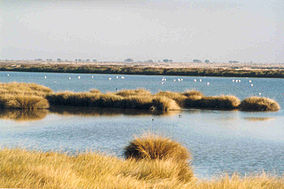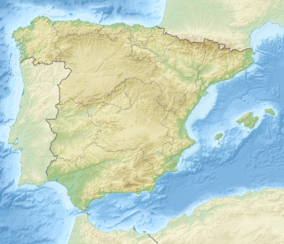- Doñana National Park
-
Doñana National Park IUCN Category II (National Park)
Wetlands in DoñanaLocation within Spain Location Huelva & Seville province - Andalusia, Spain Coordinates 37°00′00″N 6°30′00″W / 37°N 6.5°WCoordinates: 37°00′00″N 6°30′00″W / 37°N 6.5°W Area 543 km² Established 1969 Visitors 392,958 (in 2007) Governing body Ministry of the Environment Type: Natural Criteria: vii, ix, x Designated: 1994 (18th session) Reference #: 685 State Party: Spain Region: Europe and North America Extensions: 2005 Contents
Description
Conservation
In 1989 the surroundings of the national park were given more protection when a buffer zone was declared a natural park under the management of the regional government. The two parks, national and natural, have since been classified as a single natural landscape.
In 1994 UNESCO designated the park a World Heritage Site. UNESCO has also recognised the park as a Biosphere reserve. It is a wetland of international importance on the list of the Ramsar Convention.
The park has a biodiversity that is unique in Europe, although there are some similarities to the Camargue, with which Doñana is twinned. [1] Doñana contains a great variety of ecosystems and shelters wildlife including thousands of European and African migratory birds, fallow deer, Spanish red deer, wild boar, European badger, Egyptian mongoose, and endangered species such as the Spanish Imperial Eagle and Iberian Lynx.
Camels
During the 19th and 20th centuries, a herd of feral dromedaries roamed the area. They may have been introduced during the Moorish Conquest of Spain in the 8th century, or they may have escaped from a herd introduced by the Marquis de Molina as beasts of burden in 1829.[2][3] By the 1950s, there were only eight individuals left, and these were threatened by poachers.[4]
Ecological Issues
Pilgrims
The park is used by pilgrims participating in the Romería de El Rocío. As this event is attracting a million pilgrims annually, it can have a negative impact on the park's eco-systems.
Mining pollution
The park and its highly sensitive ecology were threatened in 1998 by a massive spill of metallic waste from a reservoir at the Aznalcollar mine into the Guadiamar River, which flows through the park; however, the spill was diverted into the Guadalquivir River, reprieving the park.
Impact of agriculture
In 2007, World Wildlife Fund warned that strawberry farms surrounding the park, where 95% of Spanish strawberries were produced, threatened to cause catastrophic damage to the park by depleting the surrounding groundwater, notably where illegal boreholes were involved, as well as creating considerable pesticide pollution and plastic waste which was accumulating in local creeks; AFP further reported that WWF was calling for a boycott of Spanish strawberries,[5] but this is contradicted by the remarks of a WWF-Spain spokesperson,[6] and it is uncharacteristic of WWF to call for blanket boycotts.
Notable Wildlife
-
Avocet chick.
-
Cormorants in the coast of Guadalquivir.
-
Iberian Lynx, one of the most emblematic species in the park.
A proposed location of the lost city of Atlantis
In 2011, a team of American archeologists claimed that they have found the location of the lost city of Atlantis located in the Marisma de Hinojos in the centre of the park, where its location has been predicted in 2004 [7]. The site is approximately 5 miles inland from the coast, and is located under the mudflats in the park. The archeologists suggest that a giant tsunami wiped the city off the map. They further pointed to "memorials" around the location, which are archeological sites with similarities to the Atlantean legend. The archeologists made the claim that these sites were founded by survivors of the disaster. Experts' investigations are ongoing. The archeologists' claims were shown in a special of the National Geographic Channel on March 13, 2011.[8][9]
See also
- List of Sites of Community Importance in Andalusia
- Costa de la Luz
- List of Spanish national parks
- Tartessos
References
- ^ Apart from being important for wildlife, the Camargue has a pilgrimage site, Saintes-Maries-de-la-Mer. The twinning is with the Parc Naturel Régional de Camargue. [1]
- ^ Chapman, Abel; Walter John Buck (1893). Wild Spain. London: Gurney and Jackson. pp. 94–101. http://books.google.com/books?id=tdoRAAAAYAAJ.
- ^ Chapman, Abel; Walter John Buck (1910). Unexplored Spain. New York: E. Arnold. pp. 275–282. http://books.google.com/books?id=6M4qAAAAYAAJ.
- ^ Meissner, Hans Otto (1963). Unknown Europe. trans. Florence and Isabel McHugh. London and Glasgow: Blackie & Sons. pp. 100–124.
- ^ "Call for Spain strawberry boycott". BBC News, 16/3/07
- ^ "How the thirst for strawberries is draining Spain's precious water". The Independent, 14/2/07: [2]
- ^ report by BBC report by ABC report by National Geographic report by Time magazine report by Scientific American
- ^ "Lost city of Atlantis believed found off Spain". MSNBC news, 14/3/11
- ^ Swallowed by the Sea, Simon Winchester, Newsweek, 20 March 2011. Retrieved 2011-03-25.
Further reading
- Doñana, Spain's Wildlife Wilderness, Juan Antonio Fernández, Taplinger Publishing Company, New York, 1974, hardcover, 253 pages, ISBN 0-8008-8324-1
- Where to watch birds in Doñana by Jorge Garzón , Francisco Chiclana. (2006) Published by [Lynx Edicions] ISBN 978-84-96553-20-0
- Where to watch birds in Spain. The 100 best sites by José Antonio Montero & SEO/BirdLife (2006). Published by Lynx Edicions,ISBN 978-84-96553-04-0
External links
- http://www.andalucia.com/environment/protect/donana.htm
- Doñana Biological Station CSIC
- (Spanish)Parque Nacional de Doñana (Spanish Environment Ministry)
- (Spanish)Doñana: National Park and Natural Park (Regional Government)
- CNN report on the 1998 spill
- Official UNESCO website entry
World Heritage Sites in Spain For official site names, see each article or the List of World Heritage Sites in Spain.North West Caves of Altamira and Paleolithic Cave Art of Northern Spain1 · Monuments of Oviedo and the Kingdom of the Asturias · Roman Walls of Lugo · Route of Santiago de Compostela1 · Santiago de Compostela · Tower of Hercules
North East Caves of Altamira and Paleolithic Cave Art of Northern Spain1 · Mudéjar Architecture of Aragon · Pyrénées - Mont Perdu2 · Rock-Art of the Mediterranean Basin on the Iberian Peninsula1 · Route of Santiago de Compostela1 · San Millán Yuso and Suso Monasteries · Vizcaya Bridge
Community of Madrid Aranjuez Cultural Landscape · El Escorial · University and Historic Precinct of Alcalá de Henares
Centre Archaeological Ensemble of Mérida · Archaeological Site of Atapuerca · Ávila with its Extra-mural Churches · Burgos Cathedral · Cáceres · Cuenca · Las Médulas · Rock-Art of the Mediterranean Basin on the Iberian Peninsula1 · Route of Santiago de Compostela1 · Salamanca · Santa María de Guadalupe · Segovia and its Aqueduct · Toledo · Prehistoric Rock-Art Sites in the Côa Valley and Siega Verde
East Archaeological Ensemble of Tarraco, Tarragona · Catalan Romanesque Churches of the Vall de Boí · Ibiza (Biodiversity and Culture) · Palau de la Música Catalana and Hospital de Sant Pau, Barcelona · Palmeral of Elche · Poblet Monastery · Rock-Art of the Mediterranean Basin on the Iberian Peninsula1 · Silk Exchange in Valencia · Works of Antoni Gaudí
South Alhambra, Generalife and Albayzín, Granada · Cathedral, Alcázar and Archivo de Indias, Seville · Córdoba · Doñana · Renaissance Monuments of Úbeda and Baeza · Rock-Art of the Mediterranean Basin on the Iberian Peninsula1
Canary Islands 1 Shared with other region/s · 2 Shared with France National parks of Spain
National parks of SpainNational parks Proposed Categories:- IUCN Category II
- Geography of Andalusia
- National parks of Spain
- World Heritage Sites in Spain
- Biosphere reserves of Spain
- Ramsar sites in Spain
- Special Protection Areas of Spain
- Huelva Province
- Sevilla Province
- Protected areas established in 1969
Wikimedia Foundation. 2010.






